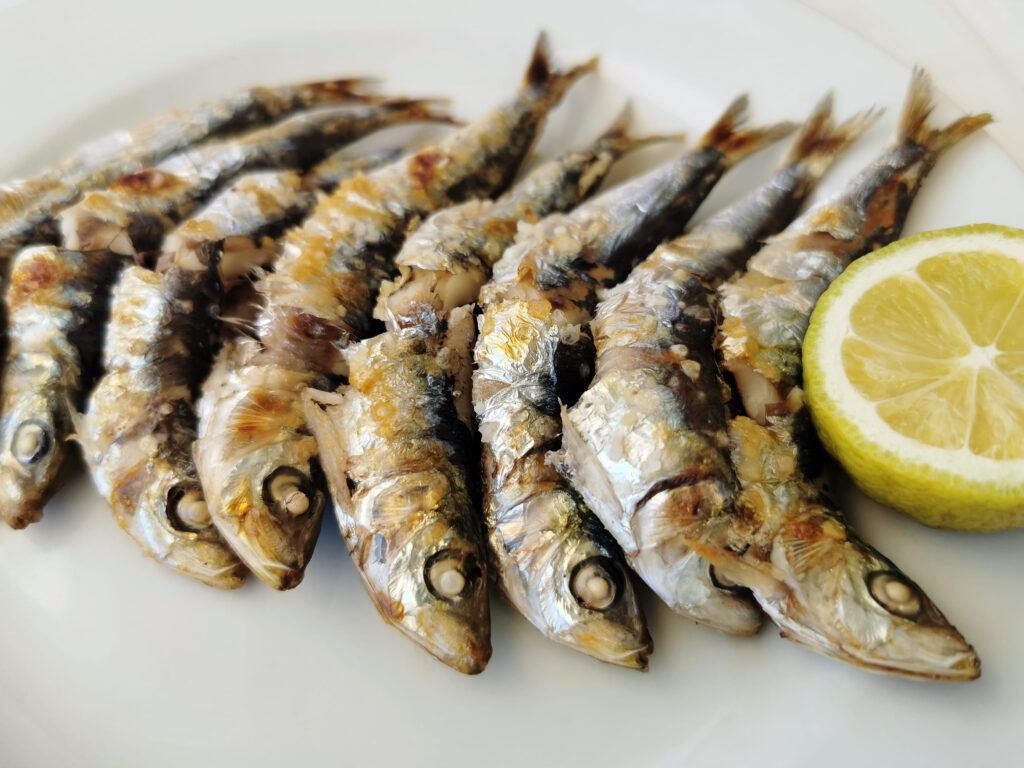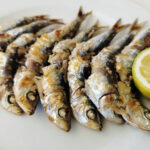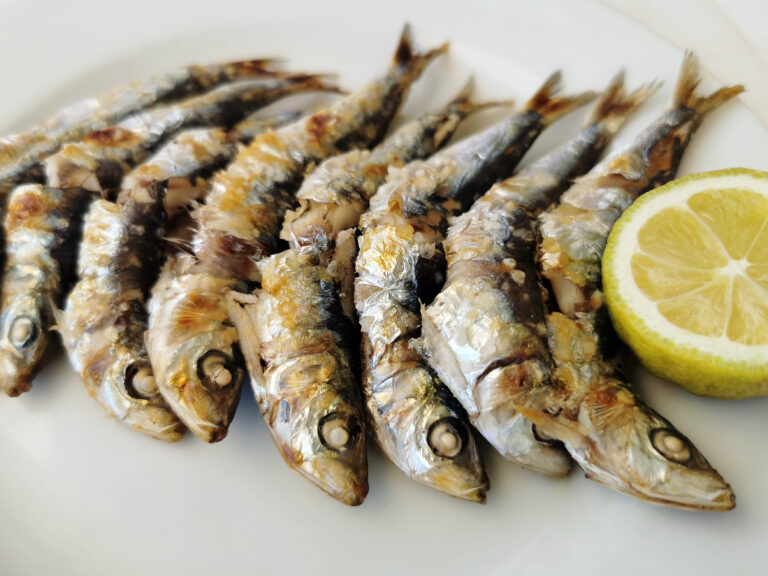Introduction
Sardines, often seen as a modest yet remarkable seafood, are a nutritional powerhouse and an incredibly versatile culinary ingredient. Rich in omega-3 fatty acids, high-quality protein, vitamins, and minerals, they provide numerous health benefits, making them an excellent addition to any diet. With a long-standing history as a staple food and their ability to adapt to modern recipes, sardines have earned their place as a favorite among food enthusiasts. As noted by The New York Times, sardines are not only nutrient-packed but also a flexible ingredient, ideal for creating flavorful and pantry-friendly meals.
What makes sardines even more appealing is their affordability and accessibility. Found fresh, frozen, or canned in nearly every grocery store, they are budget-friendly protein sources that don’t compromise on quality or flavor. Beyond their cost-effectiveness, they are also a sustainable choice. As smaller fish that are lower on the food chain, they have a minimal environmental impact compared to larger species like tuna or salmon, making them an eco-conscious option for seafood lovers.
In this blog post, we’ll explore the art of cooking sardines in detail. From selecting the highest quality options to mastering a variety of preparation and cooking techniques, this guide will provide you with the skills and inspiration to transform these small fish into mouthwatering, crowd-pleasing dishes. Additionally, we’ll share five irresistible recipes and expert tips to take your meals to the next level. Whether you’re a seasoned enthusiast or trying them for the first time, this comprehensive guide has something to offer for everyone. Let’s dive in!
Would you like me to refine this further or add any specific elements?

Why Cook small fish ?
small fish may be small, but they pack a mighty punch when it comes to nutrition, sustainability, and accessibility. Here’s why these tiny fish deserve a spot in your kitchen.
Nutritional Benefits of small fish
Sardines are often hailed as a nutritional powerhouse, offering a wide range of health benefits in every bite:
- High in Omega-3 Fatty Acids:
Omega-3s are essential fats that support brain health, reduce inflammation, and promote heart health. A single serving of small fish can provide more omega-3s than many other fish, making them a superior choice for boosting your daily intake. - Rich in Protein:
Sardines are an excellent source of high-quality protein, essential for muscle repair, immune function, and overall body maintenance. Each serving contains around 20-25 grams of protein, depending on the preparation. - Packed with Vitamins and Minerals:
Sardines are particularly rich in vitamin B12, which supports energy production and nervous system health. They are also an excellent source of vitamin D, essential for bone health and immune support. Key minerals like calcium (especially in canned sardines with bones) and selenium further enhance their nutritional profile, promoting strong bones and antioxidant defense. - Low in Mercury:
Unlike larger fish like tuna or swordfish, small fish have lower mercury levels due to their position lower on the food chain, making them a safer option for frequent consumption.
Sustainability and Environmental Impact
Choosing small fish is not only good for your health but also for the planet:
- An Eco-Friendly Seafood Choice:
Sardines are a renewable and sustainable seafood option. They reproduce rapidly, ensuring stable populations even with commercial fishing pressures. - Lower on the Food Chain:
As a small forage fish, sardines feed on plankton and require fewer resources to grow compared to larger predatory fish. This makes their farming and harvesting less resource-intensive, with a smaller carbon footprint. - Combatting Overfishing Concerns:
Overfishing is a significant issue for many popular seafood species. small fish help alleviate this problem by providing an abundant alternative, reducing pressure on overexploited fish stocks like salmon or tuna.
Affordability and Accessibility
Sardines are one of the most accessible and budget-friendly seafood options available:
- Versatile Availability:
Sardines are widely available in various forms—fresh, frozen, and canned—making them a convenient choice for home cooks. Canned sardines, in particular, are shelf-stable and perfect for quick meals. - Cost-Effective Nutrition:
Compared to other sources of protein like meat or seafood, sardines are significantly more affordable. They provide exceptional nutritional value without breaking the bank, making them an ideal option for families, students, and budget-conscious shoppers. - Ease of Preparation:
Sardines require minimal preparation, especially canned varieties that are pre-cooked and ready to eat. This convenience ensures that anyone can enjoy a healthy and delicious meal without extensive cooking skills.
Choosing the Best small fish
Choosing the right sardines is essential for creating delicious and satisfying meals. With a variety of options available—fresh, frozen, or canned—it’s important to understand what to look for to suit your preferences and recipes. This section provides practical guidance to help you select the best sardines for your culinary creations.
Fresh vs. Canned Sardines
When it comes to sardines, both fresh and canned varieties have their unique qualities. Here’s a comparison to help you decide:
- Fresh Sardines:
- Pros:
- Superior flavor and texture when cooked properly.
- Ideal for grilling, baking, or pan-frying to highlight their natural taste.
- A great choice for those who enjoy working with whole fish and experimenting with traditional recipes.
- Cons:
- Requires cleaning, scaling, and deboning, which can be time-consuming.
- Short shelf life, so they need to be consumed or frozen quickly.
- How to Identify Quality:
- Look for bright, clear eyes and shiny, firm skin.
- Fresh small fish should have a mild, ocean-like scent, not a strong fishy odor.
- Check that the flesh is firm and springs back when touched.
- Pros:
- Canned small fish:
- Pros:
- Pre-cooked, convenient, and ready to eat.
- Long shelf life, making them a reliable pantry staple.
- Versatile and available in a variety of flavors and oils.
- Cons:
- May have a softer texture compared to fresh sardines.
- Flavor can vary significantly based on the packing medium.
- How to Identify Quality:
- Choose cans that indicate sustainably sourced sardines.
- Opt for packaging that lists high-quality oils (e.g., extra virgin olive oil) and natural flavorings.
- Avoid cans that are dented, rusted, or damaged.
- Pros:
Flavor Variations in Canned small fish
Canned sardines come in a variety of packing mediums and flavor options, allowing you to tailor them to your taste preferences:
- Different Oils:
- Olive Oil: Adds a rich and smooth flavor, enhancing the sardines’ natural taste.
- Sunflower Oil: Lighter in flavor and often used for milder-tasting sardines.
- Water-Packed: A healthier, low-calorie option for those watching their fat intake.
- Added Flavors:
- Spices: Sardines packed with chili, paprika, or black pepper offer a spicy kick.
- Sauces: Options like tomato, mustard, or escabeche provide bold and distinct flavor profiles.
- Herbs: Sardines infused with rosemary, thyme, or parsley can elevate the overall taste.
When choosing canned sardines, consider your recipe and flavor preferences. For simple dishes, stick to sardines packed in olive oil. For bold, ready-to-eat snacks, try flavored varieties.
Storage and Shelf Life Tips
Proper storage is essential for maintaining the quality of sardines, whether fresh or canned:
- Fresh Sardines:
- Store fresh sardines in the refrigerator on a bed of ice, ideally in an airtight container, to keep them cold and prevent odors from spreading.
- Consume within 1-2 days of purchase for the best flavor and texture.
- For longer storage, freeze fresh sardines by wrapping them tightly in plastic wrap or aluminum foil and placing them in a freezer bag. They can last up to 3 months in the freezer.
- Canned Sardines:
- Keep unopened cans in a cool, dry place away from direct sunlight or heat.
- Check the expiration date before use; most canned sardines have a shelf life of 1-3 years.
- Once opened, transfer unused sardines to an airtight container and refrigerate. Consume within 2-3 days.

Cooking Techniques for Sardines
Sardines are remarkably versatile and can be prepared in numerous ways to cater to a wide range of tastes and occasions. Whether you’re using fresh sardines for a classic dish or canned sardines for a quick and convenient option, this section provides essential preparation steps and cooking techniques to help you unlock their full flavor potential.
Preparing Fresh Sardines
Fresh sardines require a bit of preparation, but with the right techniques, you can ensure they’re ready for delicious recipes.
- Cleaning and Deboning Fresh Sardines:
- Start by rinsing the sardines under cold water to remove any scales and debris.
- Use a sharp knife to make a shallow cut along the belly of the fish, from the head to the tail.
- Gently remove the guts and rinse the inside thoroughly.
- To debone, press your thumb along the backbone to loosen it, then gently pull the backbone out, leaving the fillets intact. For recipes requiring whole fish, you can leave the bone in for added calcium and flavor.
- Tips for Minimizing the “Fishy” Smell:
- Marinate the sardines in lemon juice or vinegar for 15-20 minutes before cooking. This helps neutralize any strong odors and enhances their fresh flavor.
- Cooking sardines with aromatic herbs (like rosemary or thyme) and spices can also reduce the “fishy” smell.
- Ensure proper ventilation in your kitchen when cooking sardines, or consider outdoor cooking methods like grilling.
Common Cooking Methods
Fresh sardines can be prepared using various cooking techniques, each offering unique flavors and textures.
- Grilling – How to Achieve the Perfect Char
- Grilling is one of the most popular methods for cooking sardines, especially in Mediterranean cuisine.
- Preheat the grill to medium-high and brush the sardines with olive oil to prevent sticking.
- Season with salt, pepper, and your favorite herbs.
- Place the small fish directly on the grill or use a fish grilling basket for easier handling.
- Cook for 3-5 minutes per side, until the skin is crispy and slightly charred, and the flesh is cooked through.
- Serve with a squeeze of lemon for a refreshing finish.
- Pan-Frying – Creating a Crispy Texture
- Pan-frying is a quick and easy way to achieve a golden, crispy exterior.
- Dredge the sardines in seasoned flour or breadcrumbs for extra crunch.
- Heat a generous amount of oil in a non-stick skillet over medium heat.
- Fry the sardines for 2-3 minutes per side until they are golden brown and cooked through.
- Drain excess oil on a paper towel before serving. Pair with a simple salad or dipping sauce for a complete meal.
- Baking – Easy Methods for Healthy Dishes
- Baking is a healthier, hands-off method for preparing sardines.
- Preheat the oven to 375°F (190°C). Arrange the sardines on a baking dish and drizzle with olive oil.
- Add sliced garlic, cherry tomatoes, and fresh herbs like parsley or oregano for added flavor.
- Bake for 15-20 minutes, or until the sardines are cooked through and slightly crisp on the edges.
- Serve with crusty bread or roasted vegetables for a wholesome dish.
Using Canned Sardines
Canned sardines are a convenient and versatile option for quick meals and snacks.
- Quick Ways to Elevate Canned Sardines for Meals:
- Heat canned sardines in olive oil with a sprinkle of chili flakes and garlic for a simple pasta topping.
- Mash them with avocado, lemon juice, and seasonings to create a flavorful sardine spread for toast or crackers.
- Add canned sardines to rice bowls, tacos, or pizza for a protein-packed boost.
- No-Cook Options for Salads and Sandwiches:
- Toss canned sardines into a Mediterranean-style salad with olives, cucumbers, tomatoes, and feta cheese.
- Layer sardines on crusty bread with fresh greens, sliced onions, and mustard for a hearty sandwich.
- Create a quick sardine ceviche by marinating them in lime juice, chopped cilantro, and diced onions.
The Ultimate Guide to Cooking Sardines: Recipes and Tips

Sardines are a versatile, nutritious, and eco-friendly seafood option, rich in omega-3 fatty acids, protein, and essential vitamins. This guide explores how to prepare and cook sardines using various techniques, from grilling and baking to incorporating them into quick meals and elegant appetizers. With practical tips, recipes, and pairing suggestions, it’s easier than ever to enjoy sardines as a delicious and budget-friendly addition to your diet. Whether you're a seasoned fan or new to sardines, this comprehensive resource will inspire creativity in the kitchen.
5 Delicious Sardine Recipes
Sardines are not only nutritious but also incredibly versatile, lending themselves to a wide array of dishes. Whether you’re looking for quick meals, impressive appetizers, or hearty main courses, these recipes highlight the best of what sardines have to offer.
Quick and Easy Recipes
For those busy days, these sardine recipes come together in minutes but pack a punch of flavor.
- Sardine Pasta with Garlic and Lemon
- Ingredients:
- 1 can of small fish in olive oil
- 250g spaghetti or linguine
- 3 cloves of garlic, thinly sliced
- Zest and juice of 1 lemon
- Chili flakes (optional)
- Fresh parsley, chopped
- Instructions:
- Cook the pasta according to package instructions and reserve ½ cup of the cooking water.
- In a large skillet, heat the oil from the sardines and sauté the garlic until fragrant.
- Add the sardines, breaking them into smaller pieces with a spoon.
- Toss in the cooked pasta, lemon zest, and juice, adding the reserved pasta water to create a silky sauce.
- Sprinkle with parsley and chili flakes for an extra kick before serving.
- Ingredients:
- Mediterranean Sardine Salad with Olives and Feta
- Ingredients:
- 1 can of sardines in water or olive oil
- Mixed salad greens (arugula, spinach, etc.)
- ½ cup cherry tomatoes, halved
- ¼ cup kalamata olives, pitted
- ¼ cup crumbled feta cheese
- Olive oil, lemon juice, salt, and pepper for dressing
- Instructions:
- Arrange the greens on a plate and top with cherry tomatoes, olives, and feta.
- Place the sardines on top, either whole or flaked.
- Drizzle with olive oil and lemon juice, and season with salt and pepper to taste.
- Ingredients:
Appetizer Ideas
Perfect for entertaining or as light snacks, these sardine appetizers are sure to impress.
- Sardine Crostini with Cream Cheese
- Ingredients:
- 1 baguette, sliced and toasted
- ½ cup cream cheese
- 1 can of sardines in olive oil
- Capers and fresh dill for garnish
- Instructions:
- Spread cream cheese on the toasted baguette slices.
- Top with a piece of sardine, a few capers, and a sprig of dill.
- Serve immediately as a simple yet elegant appetizer.
- Ingredients:
- Sardine-Stuffed Peppers
- Ingredients:
- Mini bell peppers, halved and seeded
- 1 can of sardines, mashed
- 2 tbsp cream cheese or ricotta
- 1 tbsp chopped parsley
- Salt and pepper to taste
- Instructions:
- Mix the mashed sardines with cream cheese, parsley, salt, and pepper.
- Fill each pepper half with the sardine mixture.
- Optionally, bake at 375°F (190°C) for 10 minutes or serve cold for a refreshing appetizer.
- Ingredients:
Hearty Dishes
When you’re in the mood for something more substantial, these hearty recipes are satisfying and flavorful.
- Baked small fish with Tomatoes and Herbs
- Ingredients:
- Fresh or canned small fish
- 2 cups cherry tomatoes, halved
- 3 cloves of garlic, minced
- 2 tbsp olive oil
- 1 tsp dried oregano
- Fresh basil leaves for garnish
- Salt and pepper to taste
- Instructions:
- Preheat your oven to 375°F (190°C).
- Arrange the sardines in a single layer in a baking dish.
- Scatter the cherry tomatoes and garlic over the sardines. Drizzle with olive oil and sprinkle with oregano, salt, and pepper.
- Bake for 20-25 minutes, until the tomatoes are softened and the sardines are cooked through.
- Garnish with fresh basil before serving. Enjoy with crusty bread or a side of rice.
- Ingredients:
Pro Tips for Cooking and Enjoying
Cooking and savoring sardines to their fullest potential takes a bit of know-how and careful preparation. With the right tips and techniques, you can enhance their flavor, reduce any strong aromas, and make them an appealing and versatile addition to your meals—even for those who might be hesitant to give them a try.
Reducing the “Fishy” Smell
One of the common concerns with sardines is their strong smell, but there are several effective ways to minimize it:
- Use Lemon or Vinegar:
- A quick soak in lemon juice or a mild vinegar solution (1 part vinegar to 3 parts water) for 10-15 minutes before cooking can neutralize strong odors. This also brightens the flavor of the fish.
- Incorporate Aromatic Herbs and Spices:
- Cooking sardines with fresh herbs like rosemary, thyme, parsley, or dill can help mask the “fishy” smell.
- Adding spices such as smoked paprika, cumin, or chili powder can also complement the sardines and reduce any overpowering aromas.
- Proper Ventilation:
- When cooking sardines indoors, ensure good ventilation by opening windows or using an exhaust fan. For an even better option, cook sardines outdoors on a grill to keep the smell outside.
- Freshness Matters:
- Fresh sardines tend to have a milder scent compared to older fish. Always check for freshness by ensuring the fish smells clean and has clear eyes and shiny skin.
Pairing Sardines with Other Ingredients
Sardines shine when paired with the right ingredients, creating a balanced and harmonious dish. Here are some suggestions:
- Spices and Seasonings:
- Use Mediterranean flavors like garlic, lemon zest, oregano, and basil to complement the rich taste of sardines.
- Add a touch of heat with chili flakes or cayenne pepper for a spicy kick.
- Experiment with global spices like turmeric, coriander, or smoked paprika for unique flavor profiles.
- Sauces:
- Sardines pair wonderfully with simple sauces like olive oil and garlic or vinaigrettes made with lemon juice, mustard, and capers.
- Tomato-based sauces add acidity and sweetness that balance the richness of the fish.
- Creamy sauces, such as yogurt or tahini-based dressings, can also provide a smooth contrast to the sardines’ texture.
- Complementary Sides:
- Serve sardines with fresh salads featuring crisp greens, cucumbers, and radishes for a light and refreshing accompaniment.
- Pair them with starches like roasted potatoes, couscous, or crusty bread to round out the meal.
- Grilled vegetables like zucchini, eggplant, or bell peppers also work well with sardines’ bold flavors.
Encouraging Picky Eaters to Try small fish
For kids or adults who may be hesitant to try sardines, a thoughtful approach can help make them more appealing:
- Start with Mild Preparations:
- Introduce small fish through recipes where their flavor is mellowed, such as sardine pasta, crostini, or sandwiches with other bold ingredients like avocado or mustard.
- Disguise the Appearance:
- Mash sardines into spreads or sauces so they aren’t immediately recognizable. For example, mix them with cream cheese or blend them into a tomato-based pasta sauce.
- Highlight the Health Benefits:
- Explain the nutritional value of sardines, such as their high omega-3 content and protein, as a reason to give them a try.
- Involve Them in Cooking:
- Getting kids or hesitant adults involved in preparing the sardines can make them more willing to taste the final dish.
- Pair with Familiar Flavors:
- Combinesmall fish with ingredients they already enjoy, like cheese, tomatoes, or bread. For example, a sardine melt with melted cheddar and bread can be a comforting introduction.
- Keep Portions Small:
- Start with small servings to avoid overwhelming them. A single sardine on a cracker or as part of a salad can be less intimidating than a whole dish.
Conclusion
Sardines are a culinary treasure, combining exceptional nutrition, rich flavor, and incredible versatility. Packed with omega-3 fatty acids, essential vitamins, and minerals, they are not only a healthful choice but also an eco-friendly and budget-friendly option. These qualities make them a fantastic addition to any meal plan. Whether you’re a seafood enthusiast or new to incorporating these nutrient-dense fish into your diet, this guide highlights just how simple and rewarding it is to enjoy sardines in creative and delicious ways.
With the recipes and tips shared in this post, you’re now ready to explore a variety of ways to prepare small fish, ranging from quick and flavorful pasta dishes to hearty baked meals, elegant appetizers, and refreshing salads. Their adaptability allows you to experiment with different flavors, spices, and pairings, making them a perfect choice for any palate or occasion. Don’t be afraid to get creative—these versatile fish can easily elevate any meal!
We encourage you to step out of your comfort zone and experiment with small fish in your kitchen. Whether you’re grilling them to perfection for a summer barbecue, tossing them into a refreshing salad for a quick lunch, or venturing into a new recipe for the first time, sardines bring a rich taste and impressive nutritional value that can elevate any meal. Let their versatility inspire your culinary creativity!
Now that you’re equipped with the knowledge and inspiration to cook and enjoy sardines, it’s time to get creative in the kitchen. These small yet mighty fish offer endless possibilities for nutritious and delicious meals. And if you’re looking to pair your sardine dishes with other wholesome options, consider a comforting side like a hearty lentil soup. Together, they can create a well-rounded, satisfying meal. Don’t forget to share your favorite recipes or cooking tips in the comments below—we’d love to hear from you!





